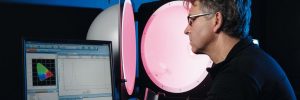Thanks to our lighting experts’ experience, our extensive software and hardware and our deep passion for lighting, we are able to satisfy our customers’ exacting lighting requirements using modern LED technology. We use Computer Aided Lighting (CAL) and the associated software, plus our very own lighting laboratory to achieve and visualise virtual lighting development.

Professional lighting development. Perfect results.
Two key success factors play a part in the development of our customised lighting solutions: excellent know-how and state-of-the-art technology. An interdisciplinary team of highly qualified lighting experts – physicists, optical experts and electronics engineers – works hand in hand with the development process from start to end, collaborating closely with the customer. Our lighting laboratory is equipped with light density cameras, spectroradiometers, lux meters and a 500 mm-diameter integrating sphere.
We use computer-aided lighting software such as SPEOS CAA, Zemax, LucidShape and LightTools to achieve and visualise virtual lighting development. By using four different types of software, we can be sure we have the very best lighting development tool for each application – and our own high-performance computers allow satisfactory simulation times.
Precise predictions instead of costly trial and error
By using modern simulation tools, we can predict the achievable lighting results for our customers before they make an investment in tools. A wide range of parameters are taken into consideration, such as the light flow, colour and intensity of the LED, the transparency, absorption, reflection and geometric shape of the materials and surfaces used, or fixed target values for the angle of observation, contrast, brightness and colour. The biggest impact on the lighting results is made by the technical parameters of the materials used for light guides, reflectors and diffusors, as well as by the LED parameters.
As the relevant LED values are often not specified accurately enough by the LED manufacturers, we measure them ourselves in our lighting laboratory. If new materials need to be developed in a project, we can collect data for this too and record it in our materials database. Consequently, over the course of many years we have built up an extensive database at our company from which data can be obtained quickly for use in light simulations.
Simulation and result
Our many years of experience show the simulation results can reproduce the real lighting situation with approx. 95% accuracy. The more parameters that are available for the simulation and the better the data for them, the more accurately the simulation reproduces reality.
In many cases, it would be possible to omit the prototype phase – which can be costly and time-consuming – where it serves purely to define and predict the final lighting result. However, this phase is still widely requested by many of our customers in order to assess integration considerations and installation space estimates using prototype-based demonstrators to prevent errors during design development.

Comparison between a simulation and the measurement of the lighting result actually achieved using a false-colour image.
Ray Tracing
![]()
Accurately calculating the physical path of up to billions of light rays enables complex lighting tasks to be accomplished.